Mark Caney's Blog, page 45
August 7, 2012
Premature dolphin calf dies at US Zoo
The Indianapolis Zoo and White River Gardens announced the arrival of two new dolphin calves on the evening of July 12, but according to the zoo, one of the calves was premature and did not survive.
“It’s a baby boom at the Indianapolis Zoo,” announced the zoo on its Facebook page on July 13th, “we celeb
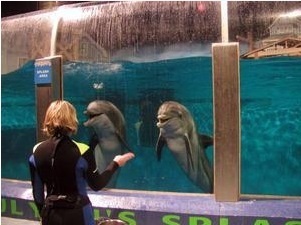 rated an African elephant birth on June 28 and last evening two of our dolphins each delivered a calf.” With the new moms and babies needing quiet time to bond, the zoo closed the Marsh Dolphin Adventure Theater to the public to allow the whole dolphin pod to adjust. On July 19th, it seemed both mothers and calves were doing well:
rated an African elephant birth on June 28 and last evening two of our dolphins each delivered a calf.” With the new moms and babies needing quiet time to bond, the zoo closed the Marsh Dolphin Adventure Theater to the public to allow the whole dolphin pod to adjust. On July 19th, it seemed both mothers and calves were doing well:The babies are bonding with their mothers and the pod is adjusting to the newcomers. This can take a while, so we ask for your patience. We’ll have more details soon. Stay tuned.
Sadly in the Breaking News sectionon the Indianapolis Zoo website, it appeared the zoo had lost one of its calves:
Due to a dolphin birth at the Zoo, the Dolphin Pavilion is temporarily closed and Dolphin Shows are not currently taking place. The new mom and calf need quiet time to bond and the whole dolphin pod needs time to adjust to the newcomer. Additionally, our trainers are devoting their full attention to the health and care of our dolphins, so the Dolphin In-Water Adventure programs are also suspended. We will post more details as they become available. Thanks for understanding.
Digital Journal contacted the Indianapolis zoo for confirmation. Judith Gagen, a Conservation Communication Specialist with the zoo told us:
Thanks so much for asking about our dolphins. We currently have one surviving dolphin calf that is doing alright so far, although we will become more confident in the coming days as he hopefully continues to gain weight and learn more. Mom is experienced and is doing a good job with nursing. The other calf was born prematurely to a first time mother, and although we were at least somewhat hopeful, congenital problems (observed in necropsy) showed problems with compromised lungs and infections. We are continuing to have “quiet time” at the Dolphin Pavilion, although we may allow some guests to come in for “keeper conversations” in the next few weeks.
Full story: Digital Journal

August 6, 2012
The dolphin spotting dog
video platform video management video solutions video player
This four-legged friend is going viral all the way from the African coast.
Kira, the black Labrador dubbed the “dolphin-spotter,” is all suited up to play with her favorite flippered friends. It’s safety first for the pup as she leaps into the water donning a life jacket.
According to the Earth Touch website, where the video was originally posted, Kira takes the plunge into the pristine waters of Ponta do Ouro in Mozambique and paddles toward the pack of dolphins.
“Kira is an ordinary dog with extraordinary friends,” according to the website. “Each day, she leaves boring canine pursuits on the shore and heads out to sea to do something much more exciting: swim with wild dolphins.”
Kira’s owner, Noleen Withers, is no stranger to dolphins either. She is the founder of the Somente Aqua Dolphin Centre in Ponta de Ouro. Apparently, the canine is such an important member of the center that it even named one of their snorkeling boats after her.
“Kira is named after Noleen’s Labrador, who accompanies most of the dolphin excursions and we like to call her the dolphin spotter,” the center’s website explains. “As Kira has a fond love for the ocean and the dolphins of Ponta it was decided to name our new boat after her.”
Source: ABC News

Tiger shark ate dolphin
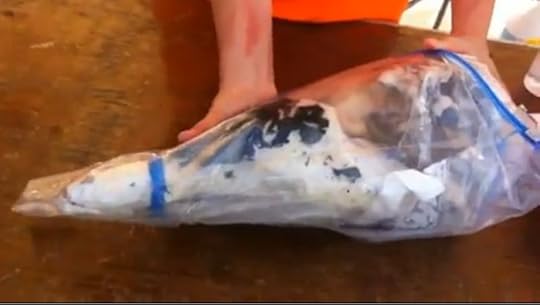
Click for video
Every summer, giant sharks take center stage at Palafox Pier and Yacht Harbor for the two-day Outcast Mega Shark Tournament.
But on Sunday, sharks had to share the limelight with what was discovered by Gulf Coast Research Laboratory scientists, who study and dissect the sharks after they’re weighed at the scales.
“This was a very interesting year,” said Jill Hendon, a fisheries biologist with the Research Laboratory, which is based at the University of Southern Mississippi. “We had a 948.6-pound tiger shark come in (Saturday). It looked very big and girthy, and we didn’t know what was in it. But when we looked at the stomach contents, this is what we found.”
Hendon smiled as she carefully held up the skull of a dolphin. Along with the skull, they found the dolphin’s tail and a long set of vertebrae.
“When we pieced it all together, we estimated that the dolphin was about 7 feet in length,” Hendon said. “It was really interesting.”
Full story and video: PNJ

August 2, 2012
Dolphins may learn how to use tools from friends
August 1, 2012
Dolphin expert sets Dolphin Way as ‘required reading’
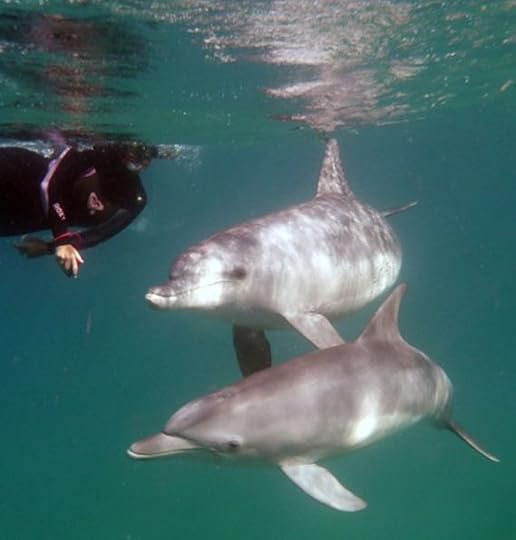
Angie Gullan with some of her “dolfriends”
Angie Gullan is the founder of Dolphin Encountours, a company specialising in taking people out to swim near wild dolphins. Based in Mozambique, Dolphin Encountours has been working in the field of ethical marine mammal tourism since the mid 90’s and has been featured on television for its unique approach to sustainable and research-driven dolphin tourism.
Angie recently read Dolphin Way: Rise of the Guardians and was so impressed that she has now made it required reading for the volunteers that assist in running the dolphin viewing tours. Angie said that the unique novel would help them to understand the remarkable intelligence of the dolphins they would be working with.
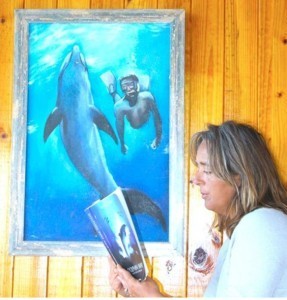
Angie reading Dolphin Way
Mark Caney, the author of Dolphin Way, said, “I am very pleased to hear Angie’s comments, as I went to a lot of trouble to ensure that the novel is based as closely as possible on fact. So it’s great to hear that someone with as much experience of wild dolphins as Angie finds it believable and enjoyable.”
Watch the video trailer for Dolphin Way:

July 31, 2012
Dolphin social networks show first hints of culture
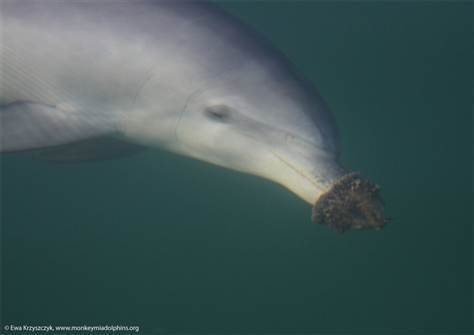 For the bottlenose dolphins of Shark Bay, Australia, functional fashion seems to be all the rage, with inclusion in cliques dependent on whether one is wearing a nose sponge — a tool that helps dolphins find food — new research suggests.
For the bottlenose dolphins of Shark Bay, Australia, functional fashion seems to be all the rage, with inclusion in cliques dependent on whether one is wearing a nose sponge — a tool that helps dolphins find food — new research suggests.
The female dolphins that wear marine basket sponges on their beaks to scour the sandy bottoms of deep channels for fish associate more with each other than with non-sponge users, the researchers said. (Sponges are filter-feeding invertebrates that come in all shapes and sizes but tend to look like sponges, as they are porous.)
These results initially surprised study co-author and behavioral biologist Janet Mann of Georgetown University in Washington, D.C. Sponge-using dolphins, called spongers, are solitary for the most part. “(At first) it seemed like the spongers weren’t that interested in a social life,” Mann said.
But over 22 years of observing the Shark Bay dolphins, a pattern emerged, and “it seemed (the spongers) were going out of their way to hang out with other spongers,” Mann said.
Mann and her colleagues compared the strength of social connections between both male and female spongers and non-spongers that lived in the same area, thereby eliminating differences in habitat that could potentially affect grouping behavior.
The scientists found that although the 36 male and female spongers associated with non-spongers, the tool-using dolphins weren’t central figures in Shark Bay dolphin society due to their isolating lifestyle. But 28 female spongers did form strong groups, or cliques, with other spongers who weren’t necessarily related to them, the researchers report in a paper published online Tuesday in the journal Nature Communications. The remaining eight male spongers tended to associate with non-spongers, researchers noted. [Creative Creatures: 10 Animals That Use Tools]
Sponging is a complex hunting tactic passed down from mother to offspring. It involves learning where sponges grow, picking the right one, prying an intact sponge from the sea bottom, and using it on their noses to root around the right areas to find fish concealed in the sand.
The fact that a socially learned behavior draws these dolphins together is an important distinction from why other animals form groups, Mann says. Circumstances, such as a communal food source, may draw animals together. Or individuals may pick up behaviors from others in their group.
But coming together because of similar behaviors learned elsewhere is what makes Shark Bay spongers a cultural first among animals, Mann and her colleagues write in their study.
Past research has found these Australian dolphins are free spirits of sorts, with the females moving freely between males in different groups.
Source: Science on NBC News By Jane J. Lee

July 30, 2012
Divided dolphin societies merge ‘for first time’
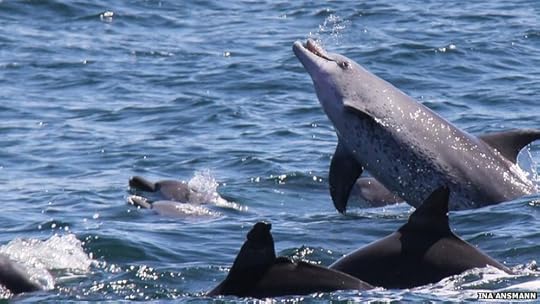 A unique social division among a population of bottlenose dolphins in Australia’s Moreton Bay has ended, according to a new study.
A unique social division among a population of bottlenose dolphins in Australia’s Moreton Bay has ended, according to a new study.
The dolphins lived as two distinct groups that rarely interacted, one of which foraged on trawler bycatch.
But scientists think that a ban on fishing boats from key areas has brought the two groups together.
They believe these socially flexible mammals have united to hunt for new food sources together.
The findings are published in the journal Animal Behaviour.
The Moreton Bay dolphins were thought to be the only recorded example of a single population that consisted of groups that were not associating with each other in a split dubbed “the parting of the pods”.
But since the study that discovered the rift, trawlers have been banned from designated areas of the bay leading to a 50% reduction in the fishing effort.
A key area of the bay to the south, where the social split was observed by the previous study, has been protected.
The changes gave scientists a unique opportunity to observe the adaptability of dolphin society.
The “trawler” dolphins from Moreton Bay had previously fed on the bycatch from boats while the “non-trawlers” found other sources of food.
“There’s never been really any experiments looking at social structure… where you can compare what it was like before and what it is like now,” said Dr Ina Ansmann, marine vertebrate ecologist, University of Queensland, and the study’s lead author.
Analysing how the population interacted before and after trawling meant the team could assess how the dolphins’ social network had changed.
“The dolphins had basically re-arranged their whole social system after trawling disappeared so they’re now actually interacting again,” Dr Ansmann told BBC Nature.
Full story: BBC
More from this site
Bottlenose dolphins have large brains and quickly learn new behaviours. Using a wide range of sounds to communicate with other members of the group, or “pod”, they have been observed showing remarkable individual and social intelligence:
One for the team: watch how a single dolphin peels off from the pod to shepherd the mullet into the open mouths of the group
Bubble trouble: initially cautious of the new shapes created by the bubble machine, you can see how quickly the inquisitive dolphins turn this experiment into a game
Mirror, mirror on the wall: from the reaction of these dolphins to their own reflection, scientists believe the animals have a developed sense of self
Thinking out cloud: see how these dolphins off the Florida coast have developed a unique hunting strategy for the shallows off the Florida coast

July 27, 2012
Scotish Beauly Firth bottlenose dolphin numbers ‘best in years’
Numbers of bottlenose dolphins visiting a Highland firth are the highest since the late 1990s, according to a conservation officer.
Twenty individuals, including seven calves, were counted on Tuesday in the Beauly Firth and Kessock Channel, near Inverness.
Charlie Phillips, of the Whale and Dolphin Conservation Society (WDCS), has been monitoring numbers for years.
He said the animals were likely to be following a good run of salmon.
Mr Phillips said: “I haven’t counted that many dolphins here for nearly 15 years.
“Let’s hope this dolphin trend continues.”
Entering the channel and Beauly Firth from the Moray Firth and the North Sea, the bottlenose dolphins are from the world’s most northerly resident population of the species.
Almost 200 dolphins are found in the North Sea and the animals are frequently seen in the Moray Firth.
Scottish Natural Heritage (SNH), which commissions a report on the health of the population every six years, said in May the population was stable and could even be increasing.
Source: BBC

July 24, 2012
‘Perfect Storm’ Behind Mass Dolphin Deaths Claims Study
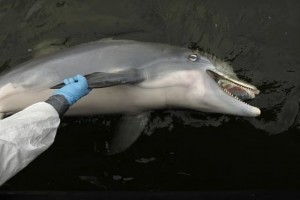 Two years after the Deepwater Horizon disaster, BP has mostly resumed normal operations in the Gulf of Mexico. But many animals in the Gulf haven’t gone back to normal.
Two years after the Deepwater Horizon disaster, BP has mostly resumed normal operations in the Gulf of Mexico. But many animals in the Gulf haven’t gone back to normal.
Researchers have connected a recent dolphin die-off to the 2010 oil spill, which likely weakened dolphins for colder conditions in Gulf waters.
According to a study from scientists at the Dauphin Island Sea Lab, published in PLoS ONE, 186 young dolphins washed ashore along Gulf coasts during a four-month period between January 1 and April 30 2011. This included 86 baby dolphins, which is six times more than the average.
University of Central Florida biologist and study researcher Graham Worthy said:
“Unfortunately, it was a ‘perfect storm’ that led to the dolphin deaths. The oil spill and cold water of 2010 had already put significant stress on their food resources. . . . It appears the high volumes of cold freshwater coming from snowmelt water that pushed through Mobile Bay and Mississippi Sound in 2011 was the final blow.
Other studies have connected the massive dolphin die-off to the BP spill. Earlier this year, the National Oceanic and Atmospheric Administration found that dolphins off the coast of Louisiana — an area significantly hit by the spill — have become seriously ill due to oil exposure. NOAA “found problems like drastically low weight, low blood sugar and, in some cases, cancer of the liver and lungs.”
Full story: ThinkProgress by Rebecca Leber

July 21, 2012
New Science Emboldens Long Shot Bid for Dolphin & Whale Rights
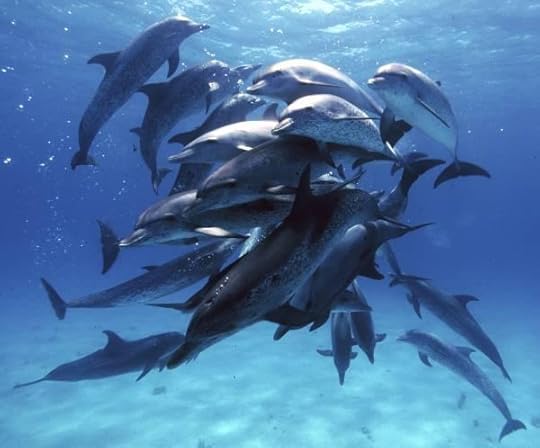 Over the last several decades, researchers have shown that many dolphin and whale species are extraordinarily intelligent and social creatures, with complex cultures and rich inner lives. They are, in a word, persons.
Over the last several decades, researchers have shown that many dolphin and whale species are extraordinarily intelligent and social creatures, with complex cultures and rich inner lives. They are, in a word, persons.
Now animal advocates are challenging society to follow science to its logical conclusion and give legal rights to cetaceans. In the next several years, they intend to make their case in a court of law. If they’re successful, a dolphin could conceivably become the first non-human ever considered a legal person.
“The problem so far is that all nonhuman animals are seen as being legal things,” said Steven Wise, an animal law scholar and attorney. “If you’re a legal person, you have the capacity to have rights. That’s the fundamental problem we intend to attack.”
Wise founded the Nonhuman Rights Project in 2007, two years after finishing a series of books on animals, rights and law. The first two, Rattling the Cage and Drawing the Line, made a case for giving legal rights to chimpanzees and bonobos, and considering other animals on a species-by-species basis. He followed those works with Though the Heavens May Fall, an account of the 1772 trial of James Somerset, the first black human recognized as a person under British law.
At the trial’s beginning, Somerset was legally considered a thing, not even permitted to speak on his behalf. At its end, he was a person. The case used by Somerset’s lawyers was an inspiration to Wise, and by the end of 2013 the Nonhuman Rights Project plans to file two lawsuits on behalf of individual animals held in captivity in the United States.
To be sure, it will be an underdog’s battle, and might even be called quixotic. “There would be tremendous resistance. People would worry — ‘What are the limits? Is every animal in a zoo going to have a lawyer?’” said Richard Posner, a judge on the 7th U.S. Circuit Court of Appeals. “In the foreseeable future it wouldn’t have traction.”
But Wise is undaunted by the challenge. In the 30 years since he started working in animal law, Wise said, society has changed in ways that once seemed radical: Ethical vegetarianism is mainstream, cute animal videos rule our collective subconscious, and people like himself are invited to lecture at Harvard. “What’s never been done doesn’t seem like it’s doable,” he said.
Whether the Nonhuman Rights Project’s first case will involve a cetacean is yet to be determined. If personhood is defined by character rather than chromosomes, many creatures would be eligible: Great apes are intelligent, empathic and emotional, as are elephants. But perhaps the most vocal support exists for cetaceans.
“We have all the evidence to show that there is an egregious mismatch between who cetaceans are and how they are perceived and still treated by our species,” said evolutionary neurobiologist Lori Marino of Emory University during a February meeting of the American Association for the Advancement of Science. “These characteristics make it ethically inconsistent to deny the basic rights of cetaceans.”
Read full story: Wired Science





